Permaculture companion plants for Dill
| Image | Name | Data | Description | Actions |
|---|---|---|---|---|

|
Carrot |
3-10
Biennial
Full sun
Moist
Light (sandy), Medium, Heavy (clay)
1.2
Leaves, Root
Apiaceae or Umbelliferae
Möhre, Karotte
https://pfaf.org/User/Plant.aspx?LatinName=Daucus carota sativus
Afghanistan, Albania, Algeria, Austria, Azores, Baleares, Baltic States, Belarus, Belgium, Bulgaria, Canary Is., Cape Verde, Central European Rus, China South-Central, China Southeast, Corse, Cyprus, Czechoslovakia, Denmark, East Aegean Is., East European Russia, Eritrea, Ethiopia, France, Germany, Great Britain, Greece, Hungary, Iran, Iraq, Ireland, Italy, Kazakhstan, Kirgizstan, Kriti, Krym, Lebanon-Syria, Libya, Madeira, Morocco, Nepal, Netherlands, North Caucasus, Northwest European R, Norway, Pakistan, Palestine, Poland, Portugal, Romania, Sardegna, Sicilia, South European Russi, Spain, Sweden, Switzerland, Tadzhikistan, Transcaucasus, Tunisia, Turkey, Turkey-in-Europe, Turkmenistan, Ukraine, Uzbekistan, West Himalaya, Yugoslavia
Alabama, Amsterdam-St.Paul Is, Andaman Is., Angola, Argentina Northeast, Argentina Northwest, Argentina South, Arizona, Arkansas, Bangladesh, Brazil South, British Columbia, California, Cape Provinces, Chile Central, Chile South, China North-Central, Colorado, Connecticut, Costa Rica, Cuba, Delaware, Desventurados Is., District of Columbia, Dominican Republic, Easter Is., Ecuador, El Salvador, Finland, Florida, Georgia, Guatemala, Hainan, Haiti, Iceland, Idaho, Illinois, India, Indiana, Inner Mongolia, Iowa, Jamaica, Japan, Jawa, Kansas, Kentucky, Kermadec Is., Korea, Labrador, Leeward Is., Louisiana, Maine, Manchuria, Manitoba, Marianas, Marshall Is., Maryland, Massachusetts, Mauritius, Mexico Central, Mexico Northeast, Michigan, Minnesota, Mississippi, Missouri, Mongolia, Montana, Myanmar, Nebraska, Nevada, New Brunswick, New Hampshire, New Jersey, New Mexico, New York, New Zealand North, New Zealand South, Newfoundland, Nicobar Is., North Carolina, North Dakota, North European Russi, Northern Provinces, Nova Scotia, Ohio, Oklahoma, Ontario, Oregon, Pennsylvania, Peru, Primorye, Prince Edward I., Puerto Rico, Qinghai, Québec, Rhode I., Rodrigues, Réunion, Saskatchewan, South Carolina, South Dakota, Sri Lanka, Sudan, Tasmania, Tennessee, Texas, Tibet, Trinidad-Tobago, Uruguay, Utah, Vermont, Vietnam, Virginia, Washington, West Siberia, West Virginia, Wisconsin, Wyoming, Xinjiang
0.20
https://powo.science.kew.org/taxon/urn:lsid:ipni.org:names:841063-1
|
Carrot (Daucus carota sativus) is a type of root vegetable that is native to Europe and Asia. It belongs to the family Apiaceae, which includes around 300 species of plants. Carrots are a popular crop, known for their sweet, crunchy roots and vibrant orange color. The plant has a tall, slender growth habit and can reach a height of up to 2-3 feet. The leaves are green and feathery, and the flowers are small and white or purple in color. To grow carrots successfully, it is important to choose a location with well-drained, sandy soil and full sun. The plant prefers cool temperatures and should be protected from frost. Carrots can also be grown in containers, and will benefit from regular watering and fertilization. The plant is relatively easy to grow and requires little maintenance, but can be susceptible to pests and diseases, such as carrot fly and root rot. Carrots are a valuable source of vitamins and minerals, and are used in a variety of dishes, including soups, stews, and salads. The roots can be eaten fresh or cooked, and can be stored in the refrigerator for several weeks. In addition to their culinary uses, carrots have a number of medicinal properties, and have been used to treat a variety of ailments, including indigestion, constipation, and respiratory disorders. Carrots are also a valuable food source for many types of wildlife, including birds, insects, and small mammals. The flowers attract bees and other pollinators, and the roots are eaten by animals such as rabbits and deer. |
Show
Edit |
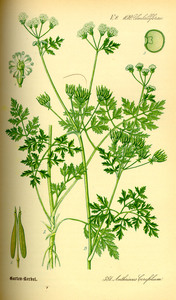
|
Chervil |
https://en.wikipedia.org/wiki/Chervil
true
Moist
Full sun, Partial sun/shade, Full shade
6-9
Garden chervil
Light (sandy), Medium, Heavy (clay)
Apiaceae or umbelliferae
0.5
Echte kerbel
Leaves, Root
Biennial
https://pfaf.org/User/Plant.aspx?LatinName=Anthriscus cerefolium
Afghanistan, Albania, Algeria, Austria, Baleares, Belgium, Bulgaria, Canary Is., Corse, Cyprus, Czechoslovakia, Denmark, East Aegean Is., Egypt, France, Germany, Greece, Gulf States, Hungary, India, Iran, Iraq, Italy, Kazakhstan, Kirgizstan, Kriti, Krym, Lebanon-Syria, Libya, Madeira, Morocco, Netherlands, North Caucasus, Oman, Pakistan, Palestine, Poland, Portugal, Romania, Sardegna, Saudi Arabia, Sicilia, Sinai, Spain, Sweden, Switzerland, Tadzhikistan, Transcaucasus, Tunisia, Turkey, Turkey-in-Europe, Turkmenistan, Uzbekistan, West Himalaya, Xinjiang, Yugoslavia
Alabama, Argentina Northeast, Arizona, British Columbia, California, Chile Central, District of Columbia, Florida, Georgia, Great Britain, Ireland, Japan, Korea, Maryland, Massachusetts, Michigan, New Jersey, New South Wales, New York, New Zealand North, New Zealand South, North Carolina, Ohio, Ontario, Oregon, Pennsylvania, Rhode I., Saskatchewan, South Australia, South Carolina, South Dakota, Tasmania, Tennessee, Texas, Victoria, Washington
https://powo.science.kew.org/taxon/urn:lsid:ipni.org:names:40487-1
|
Show
Edit |
|
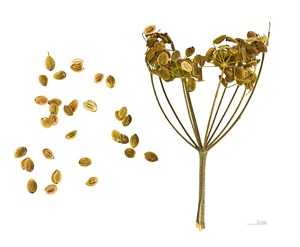
|
Parsnip |
https://en.wikipedia.org/wiki/Parsnip
true
Moist
Full sun, Partial sun/shade
4-8
Wild parsnip
Light (sandy), Medium, Heavy (clay)
Apiaceae or umbelliferae
1.0
Pastinake
Roots
Leaves, Root, Seed
Weed potential
Biennial
https://pfaf.org/User/Plant.aspx?LatinName=Pastinaca sativa
Sicilia
Albania, Altay, Austria, Baltic States, Belarus, Belgium, Bulgaria, Central European Rus, Corse, Czechoslovakia, East European Russia, France, Germany, Great Britain, Greece, Hungary, Italy, Krasnoyarsk, Krym, Lebanon-Syria, Mongolia, Netherlands, North Caucasus, Poland, Romania, Sardegna, South European Russi, Spain, Switzerland, Transcaucasus, Turkey, Turkey-in-Europe, Ukraine, West Siberia, Yugoslavia
https://powo.science.kew.org/taxon/urn:lsid:ipni.org:names:845768-1
0.4
|
Show
Edit |
|

|
Broccoli |
2-11
Annual, Biennial
Full sun, Partial sun/shade
Moist
Light (sandy), Medium, Heavy (clay)
0.9
Flowers, Leaves
Brassicaceae or Cruciferae
Brokkoli
https://pfaf.org/User/Plant.aspx?LatinName=Brassica oleracea italica
50-100
45cm
6.0-7.0
7-10 days
4°C (40°F)
6-8 weeks before last frost
3 to 7 years
|
Broccoli is a plant that is native to the Mediterranean region. It is part of the Brassica oleracea family, which also includes other vegetables such as cauliflower and cabbage. Broccoli plants have green, flowering heads that are similar in appearance to cauliflower. The stems are typically thick and can grow to be quite large, depending on the variety of broccoli. The leaves of the plant are typically dark green and are arranged in a spiral pattern along the stem. When it comes to growing conditions, broccoli prefers cool weather and well-draining soil. It is a relatively fast-growing plant, with the flowering heads typically forming in the first year. To cultivate broccoli successfully, a grower will need to make sure the plant gets enough water and sunlight, and provide it with the necessary nutrients through fertilization. In terms of winter hardiness, broccoli is not very frost-tolerant, so it is typically grown as a cool-season crop in areas with mild winters. In terms of edibility, broccoli is a very nutritious vegetable that is packed with vitamins and minerals. The flowering heads and the stems are both edible, and can be cooked in a variety of ways. After harvest, broccoli can be stored in the refrigerator for several days, or frozen for longer-term storage. ### Propagation - Direct sow Sow seeds 7cm apart, thin when seedlings reach 5-7cm in height. ### Propagation - Transplant Start seeds 6-8 weeks before your last frost date, or 2-3 weeks before last frost date. Plant outside when seedlings are 4-6 weeks old, or have 4-5 leaves. #### Links [Broccoli @ Almanac](https://www.almanac.com/plant/broccoli) |
Show
Edit |
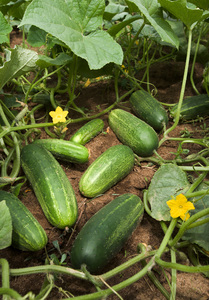
|
Cucumber |
9-11
Annual
Full sun
Moist
Light (sandy), Medium, Heavy (clay)
2
Vines
Fruit, Leaves
Seed - direct sow, Seed - transplant
1 week after last frost
https://en.wikipedia.org/wiki/Cucumber
Cucurbitaceae
Gurke
50-65
23cm
6.0-6.8
15-30°C (60-85°F)
https://pfaf.org/User/Plant.aspx?LatinName=Cucumis sativus
True
Fruit
Assam, Bangladesh, China South-Central, China Southeast, East Himalaya, Myanmar, Nepal, Thailand, West Himalaya
Alabama, Albania, Andaman Is., Arizona, Arkansas, Austria, Bahamas, Bolivia, Caroline Is., Cayman Is., Colombia, Costa Rica, Cuba, Czechoslovakia, Denmark, Dominican Republic, Ecuador, Florida, Georgia, Gulf of Guinea Is., Haiti, Illinois, India, Jamaica, Kansas, Kazakhstan, Kentucky, Korea, Laos, Leeward Is., Louisiana, Marianas, Marshall Is., Massachusetts, Michigan, Mississippi, Missouri, New Caledonia, New York, Nicaragua, Nicobar Is., North Carolina, North Caucasus, Ohio, Oman, Ontario, Pakistan, Pennsylvania, Pitcairn Is., Puerto Rico, South Carolina, Sri Lanka, Sweden, Tadzhikistan, Trinidad-Tobago, Turkmenistan, Utah, Uzbekistan, Venezuela, Vietnam, Virginia, Windward Is., Zaïre
2-3 weeks before last frost
1 week after last frost
0.9
https://powo.science.kew.org/taxon/urn:lsid:ipni.org:names:292296-1
|
Cucumber, scientific name Cucumis sativus, is a member of the gourd family. It is native to India and other parts of Asia. Cucumber is a trailing or climbing plant that grows to a height of 5-10 feet. The leaves are dark green and glossy, and the plant produces yellow flowers. The fruit of the cucumber plant is a long, green, edible vegetable with a thin skin. Cucumbers are typically about 6-9 inches long and 2-3 inches in diameter. In terms of growth and cultivation, cucumber plants prefer warm, sunny conditions and well-draining soil. They should be watered regularly, especially during dry periods. Cucumber plants are not winter hardy and should be grown in the summer months in most climates. To cultivate cucumbers successfully, it is important to provide them with adequate space to grow and to support the plants with trellises or other means to keep the fruits off the ground. The plant will develop male and female flowers. You can recognize the female by having a tiny cucumber underneath. Sometimes the plant develops a lot of male flowers first, so be patient. If you don’t see any bees pollinating. Take a male and put it on all the female flowers. Cucumber fruits are edible and can be eaten raw, pickled, or cooked. The skin and seeds of the cucumber are edible, but some people choose to remove the seeds before eating the fruit. Cucumber fruits can be stored in the refrigerator for a few days after harvest. Cucumbers have several uses. In addition to being eaten as a vegetable, they can also be used in a variety of dishes and salads. Cucumber slices are often used as a garnish or as a refreshing addition to beverages. Cucumbers are also commonly used in natural skin care products and are believed to have anti-inflammatory and soothing properties. #### Propagation Direct sow when soil is warm enough in early summer. Sow seeds individually indoors 3-4 weeks before planting outside into warm soil. Use bottom heat if possible. Transplant when plants develop third leaf. #### Medicinal Fruit is depurative, diuretic, emollient, purgative and resolvent #### Links [Cucumber @ West Coast Seeds](https://www.westcoastseeds.com/products/patio-snacker) |
Show
Edit |
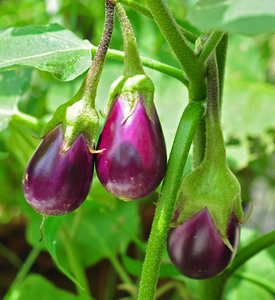
|
Eggplant |
8-11
Full sun
Moist
Light (sandy), Medium, Heavy (clay)
1.0
1
Perennial
true
Fruit, Leaves
Eggplant
Aubergine
Solanaceae
China South-Central, Laos, Malaya, Myanmar, Thailand, Vietnam
Assam, Bangladesh, Cambodia, East Himalaya, India, Kazakhstan, Laccadive Is., Sri Lanka, Tadzhikistan, Turkmenistan, Uzbekistan, Zaïre
https://en.wikipedia.org/wiki/Eggplant
https://pfaf.org/User/Plant.aspx?LatinName=Solanum melongena
https://powo.science.kew.org/taxon/urn:lsid:ipni.org:names:820053-1
|
The eggplant, also known as Solanum melongena, is a plant that is native to India and Southeast Asia. It is typically an annual plant. It is a member of the nightshade family and is closely related to other vegetables such as tomatoes and peppers. Eggplants are typically recognized by their deep purple, spongy fruit, but they can come in a variety of sizes and colors (white, green, black, purple striped). The fruit is elongated and cylindrical in shape, and can grow to be anywhere from 6-12 inches in length. The leaves of the eggplant are broad and dark green in color, and the plant itself can grow to be quite tall, reaching heights of 3-4 feet. Eggplants prefer warm, sunny growing conditions and can be grown in a wide range of soils as long as they are well-draining. They are typically grown as a summer crop, and will begin to produce fruit around 2-3 months after planting. To cultivate eggplants successfully, a grower will need to provide the plants with adequate water and nutrients, and may need to use stakes or other supports to help the plant grow upright. Eggplants are not winter hardy and will not survive freezing temperatures. The fruit of the eggplant is edible and is often used in a variety of dishes, particularly in Mediterranean and Asian cuisines. It can be sliced and fried, grilled, or used in stews and soups. The skin of the fruit is typically removed before eating, and the flesh can be stored in the refrigerator for a few days after harvesting. In addition to being used as a food source, eggplants have also been used for medicinal purposes in some cultures. The plant is believed to have anti-inflammatory properties, and has been used to treat a variety of ailments including headache and rheumatism. It is also sometimes used as a natural insect repellent. |
Show
Edit |
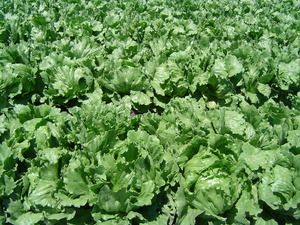
|
Lettuce |
5-9
Annual, Biennial
Full sun, Partial sun/shade
Moist
Light (sandy), Medium
0.9
Herbs
true
Leaves, Seed
https://en.wikipedia.org/wiki/Lettuce
Garden lettuce
Asteraceae or compositae
Blattsalat
Oil
https://pfaf.org/User/Plant.aspx?LatinName=Lactuca sativa
Iraq
Alabama, Antipodean Is., Argentina Northeast, Assam, Austria, Baleares, Baltic States, Bangladesh, Belize, Bolivia, Bulgaria, Burkina, California, Cameroon, Canary Is., Cape Provinces, Cape Verde, Caroline Is., Central European Rus, Chad, China North-Central, Colombia, Connecticut, Corse, Costa Rica, Cuba, Cyprus, Czechoslovakia, Delaware, District of Columbia, Dominican Republic, East European Russia, East Himalaya, Ecuador, Egypt, El Salvador, Fiji, Finland, France, Free State, Germany, Great Britain, Guatemala, Haiti, Hawaii, Honduras, Hungary, Idaho, Illinois, Indiana, Inner Mongolia, Ireland, Italy, Jamaica, Jawa, Kazakhstan, Khabarovsk, Korea, Krym, Lebanon-Syria, Madeira, Maine, Marianas, Marshall Is., Massachusetts, Mauritania, Mauritius, Mexico Southeast, Michigan, Missouri, Myanmar, Nepal, Netherlands, New Guinea, New Hampshire, New Jersey, New Mexico, New York, Nicaragua, Niue, North Carolina, North Caucasus, North Dakota, North European Russi, Northwest European R, Ohio, Oklahoma, Oman, Ontario, Oregon, Pakistan, Panamá, Paraguay, Pennsylvania, Peru, Philippines, Poland, Portugal, Primorye, Puerto Rico, Rhode I., Romania, Réunion, Sardegna, Sicilia, South European Russi, Spain, Sweden, Switzerland, Taiwan, Transcaucasus, Trinidad-Tobago, Tubuai Is., Turkey, Turkey-in-Europe, Ukraine, Uzbekistan, Venezuela, Vermont, Vietnam, Wake I., Washington, West Virginia, Yugoslavia
30cm
https://powo.science.kew.org/taxon/urn:lsid:ipni.org:names:228239-1
|
Lettuce, Lactuca sativa, is a plant native to the Mediterranean region. It has green, elongated leaves that form a loose head. The stem is relatively short and the plant grows to a height of about 8-12 inches. Lettuce is a fast-growing plant, with some varieties able to be harvested in as little as 45 days. Lettuce can be differentiated from similar plants by its elongated leaves and loose head formation. It is also relatively short compared to other leafy green plants like kale and spinach. Lettuce prefers cool temperatures and grows best in full sun or partial shade. It is a hardy plant and can tolerate light frost, but will not survive extreme cold. To cultivate lettuce successfully, growers should ensure that the soil is well-drained and moist, and that the plants are spaced appropriately. Lettuce is edible and the leaves can be eaten raw in salads or cooked. The leaves can also be stored by washing and drying them, and then wrapping them in a damp paper towel before placing them in the refrigerator. Lettuce has a number of uses. It is a popular ingredient in salads and other dishes, and has been used medicinally to treat a variety of ailments, including insomnia and digestive issues. |
Show
Edit |

|
Onion |
3-9
Annual
Full sun
Moist
Light (sandy), Medium
0.6
Herbs
Bulb, Flowers, Leaves, Root, Seed
Seed - direct sow, Seed - transplant
https://en.wikipedia.org/wiki/Onion
Garden onion
Alliaceae
Zwiebel
https://pfaf.org/User/Plant.aspx?LatinName=Allium cepa
50°f, 10°c
Seed indoors 6 weeks before transplanting in the garden
2-6 inches
6.0-7.0
Allium
Turkmenistan
Algeria, Argentina Northeast, Arkansas, Baltic States, Bangladesh, Belarus, Bulgaria, California, Cambodia, Canary Is., Central European Rus, China North-Central, China South-Central, China Southeast, Colombia, Cuba, Czechoslovakia, Dominican Republic, East Aegean Is., East European Russia, East Himalaya, Ecuador, Egypt, Ethiopia, Fiji, France, Galápagos, Guinea-Bissau, Haiti, Illinois, India, Iraq, Italy, Jamaica, Kansas, Kentucky, Kirgizstan, Korea, Krym, Libya, Louisiana, Madeira, Manchuria, Mauritania, Mexico Central, Mexico Gulf, Mexico Northeast, Mexico Southeast, Mexico Southwest, Minnesota, Montana, Morocco, New York, Niue, North European Russi, Northwest European R, Oregon, Pakistan, Puerto Rico, Seychelles, South European Russi, Spain, Tadzhikistan, Texas, Thailand, Tibet, Tonga, Trinidad-Tobago, Ukraine, Uzbekistan, Vermont, Washington, West Himalaya, West Siberia, Wisconsin, Xinjiang, Yugoslavia
Spring or fall
0.3
https://powo.science.kew.org/taxon/urn:lsid:ipni.org:names:527795-1
|
Onion (Allium cepa) is a plant species in the family Amaryllidaceae. It is native to central Asia and is commonly grown as a vegetable in many parts of the world. Onions are biennial plants, meaning they typically have a two-year life cycle. In the first year, the onion forms a small, rounded bulb with thin, papery skin. In the second year, the onion will produce a tall stem with hollow, elongated leaves and a small, spherical flower head. Onions are typically grown for their bulbs, which are used as a food ingredient in many dishes. The bulbs can vary in size and shape, depending on the variety, but are generally spherical or oblong in shape and range in size from about 2-4 inches in diameter. Onions are commonly differentiated by their color, which can range from white to yellow to red. Onions prefer well-drained soil that is rich in organic matter. They should be planted in a sunny location and will benefit from regular watering, especially during dry periods. Onion bulbs can be harvested when they reach the desired size, typically after about 100-150 days of growth. To store onions, they should be dried and cured in a cool, dry place for about two weeks before being placed in a mesh bag or other breathable container. Onions are edible and are commonly used as a food ingredient in many dishes. The bulbs are the most commonly used part of the plant, but the leaves and stems can also be used in cooking. Onions have a pungent, spicy flavor and are often used to add flavor to soups, stews, and other dishes. Onions can be stored for several months if properly dried and cured. In addition to their use as a food ingredient, onions have also been used for their medicinal properties. They have been used to treat a variety of ailments, including coughs, colds, and respiratory infections. Onions are also sometimes used as a natural fertilizer, due to the high levels of sulfur and other nutrients they contain. Onions are not known to provide significant value to wildlife. They are not a preferred food source for most animals and do not provide any significant habitat value. However, some insects, such as the onion maggot, can be pests of onion crops. |
Show
Edit |
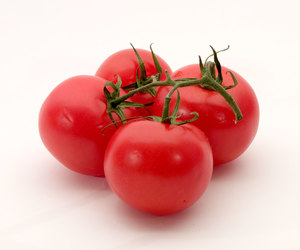
|
Tomato |
10-12
Annual, Perennial
Full sun
Moist
Light (sandy), Medium, Heavy (clay)
2.0
True
Fruit, Seed
https://en.wikipedia.org/wiki/Tomato
Fast
Garden tomato, Dumádu, Garden tomato, Love apple, Lycopersicum esculentum, Tomate, Tomato, Tomato extract containing lycopene, Tomato|thakkali, Tumatis, Lycopersicon esculentum
Solanaceae
Tomate
Oil
https://pfaf.org/User/Plant.aspx?LatinName=Solanum lycopersicum, https://pfaf.org/User/Plant.aspx?LatinName=Lycopersicon esculentum
Start seeds indoors 5-6 weeks before last frost
In containers or in rows in beds around last frost date
6.2-6.8
70-80°f
Peru
Alabama, Alaska, Andaman Is., Angola, Arizona, Arkansas, Assam, Austria, Azores, Bahamas, Bangladesh, Belarus, Benin, Bolivia, British Columbia, Bulgaria, Burkina, California, Cambodia, Cameroon, Canary Is., Cape Verde, Caroline Is., Central African Repu, Chagos Archipelago, Chatham Is., Christmas I., Colombia, Comoros, Connecticut, Cook Is., Costa Rica, Cuba, Cyprus, Czechoslovakia, Delaware, Dominican Republic, East Aegean Is., East European Russia, East Himalaya, Ecuador, Fiji, Florida, Galápagos, Georgia, Gilbert Is., Gulf of Guinea Is., Haiti, Hawaii, Illinois, India, Indiana, Iowa, Ivory Coast, Jawa, Kansas, Kazakhstan, Kentucky, Korea, Laccadive Is., Laos, Leeward Is., Line Is., Louisiana, Madagascar, Madeira, Maine, Malawi, Mali, Marianas, Marquesas, Marshall Is., Maryland, Massachusetts, Mauritania, Mauritius, Michigan, Mississippi, Missouri, Montana, Mozambique, Myanmar, Namibia, Nansei-shoto, Nauru, Nebraska, Nepal, Nevada, New Brunswick, New Caledonia, New Hampshire, New York, New Zealand North, Nicaragua, Nicobar Is., Niue, North Carolina, North Dakota, Nova Scotia, Ogasawara-shoto, Ohio, Ontario, Oregon, Pakistan, Panamá, Pennsylvania, Philippines, Pitcairn Is., Puerto Rico, Québec, Rhode I., Réunion, Saskatchewan, Selvagens, Society Is., South Carolina, South European Russi, Tadzhikistan, Taiwan, Tennessee, Texas, Trinidad-Tobago, Tuamotu, Tubuai Is., Turkey, Turkmenistan, Tuvalu, Utah, Uzbekistan, Venezuela, Vermont, Vietnam, Virginia, Wake I., Wisconsin, Zambia, Zaïre, Zimbabwe
1.00
https://powo.science.kew.org/taxon/urn:lsid:ipni.org:names:316947-2
|
The tomato is a flowering plant native to South America. It is a member of the nightshade family and closely related to the potato. The tomato plant typically grows to a height of 1-3 meters and has a weak, hairy stem. The leaves are arranged alternately on the stem and are typically dark green in color. The plant produces small yellow or white flowers, which develop into the fruit we know as tomatoes. The fruit itself is typically red, but can also be yellow, orange, green, or purple. Indeterminate tomato plants are perennials in their native habitat, but are cultivated as annuals. Determinate, or bush, plants are annuals that stop growing at a certain height and produce a crop all at once. Tomatoes prefer warm, sunny growing conditions and well-drained, humus-rich soil. They can be grown in a variety of soil types, but perform best in soil with a pH between 6 and 6.8. In order to cultivate tomatoes successfully, growers may need to provide support for the plant (such as a stake or cage) to prevent the fruit from weighing down the stem, and may also need to water and fertilize the plant regularly. Tomatoes are generally considered to be frost-sensitive, so in areas with cold winters they may need to be grown in a greenhouse or indoors. There are a great number of cultivars. The edible parts of the tomato plant are the fruit and the leaves. The fruit can be eaten raw or cooked, and is commonly used in a variety of dishes, such as salads, sandwiches, and pasta. The leaves, although not commonly eaten, are also edible and have a slightly bitter taste. After harvest, tomatoes can be stored at room temperature, in a cool place, or in the refrigerator. |
Show
Edit |
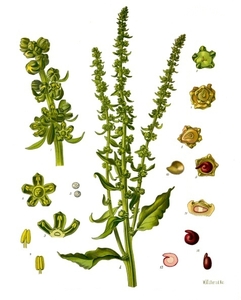
|
Beet |
4-8
Biennial
Full sun
Moist
Light (sandy), Medium, Heavy (clay)
Deciduous
0.9
True
Leaves, Root
Seed - direct sow, Seed - transplant
2 weeks before last frost
https://en.wikipedia.org/wiki/beta_vulgaris
Chenopodiaceae
Rübe
https://pfaf.org/user/plant.aspx?latinname=beta vulgaris craca
6.0-6.8
10°c (50°f)
5-12 days
1.5 cm
20cm
45-65
Beta vulgaris subsp. vulgaris Conditiva Group, beetroot
6-8 weeks before last frost
2-3 weeks before last frost, 6-8 weeks before the first frost
2-3 years
0.25
|
Beet (Beta vulgaris vulgaris), also known as garden beet, red beet, or table beet, is a plant that is native to the Mediterranean region. It is a biennial plant that typically grows to a height of 0.5-1.5 feet and has dark green leaves that are long and rounded, with a smooth or slightly hairy texture. The stem is usually light green in color, and the plant produces small, white or yellow flowers. Beet plants grow best in well-drained soil that is rich in organic matter, and they prefer full sun to partial shade. To cultivate beets successfully, a grower will need to keep the soil moist and weed-free, and may need to thin the plants to allow for proper growth. Beets are edible, and the most commonly eaten part of the plant is the root, which is typically red or purple in color. The leaves of the plant can also be eaten, and are often used in salads. Beets can be stored after harvest by washing and trimming the roots, and then storing them in a cool, dark place. Beets have a number of uses, both culinary and non-culinary. In the kitchen, beets can be cooked in a variety of ways, including boiling, roasting, and grilling. They can also be used to add color and flavor to salads, soups, and stews. In addition to their culinary uses, beets have a number of medicinal properties and have been used to treat a variety of ailments, including indigestion, constipation, and inflammation. Beets are also valuable for their ability to improve soil fertility, as their leaves and roots contain high levels of nitrogen and other nutrients. They can be used as a natural fertilizer, and can also be used as a mulch or as a ground cover to help control weeds. Beets are not particularly attractive to wildlife, but they can provide food for a variety of animals, including deer, rabbits, and birds. Overall, beets are a versatile and valuable plant that is widely cultivated by gardeners and farmers for their edible roots and leaves, as well as for their potential uses in medicine and agriculture. ### Links [How to Grow Beets @ Harvest to Table](https://harvesttotable.com/how_to_grow_beets/) |
Show
Edit |

|
Brussel Sprouts |
Full sun, Partial sun/shade
Moist
Light (sandy), Medium, Heavy (clay)
1.2
0.2
Biennial
3 to 7 years
true
Leaves
Rosenkohl
Brassicaceae or cruciferae
https://pfaf.org/User/Plant.aspx?LatinName=Brassica oleracea gemmifera
|
A leaf vegetable in the cabbage family. |
Show
Edit |

|
Cauliflower |
3-10
Annual, Biennial
Full sun, Partial sun/shade
Moist
Light (sandy), Medium, Heavy (clay)
0.8
true
Flowers, Leaves
Brassicaceae or cruciferae
Blumenkohl
https://pfaf.org/User/Plant.aspx?LatinName=Brassica oleracea botrytis
3-7 years
|
Annual plant reproduced by seed. |
Show
Edit |
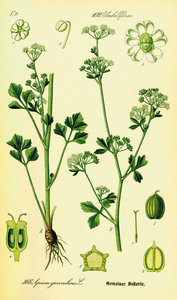
|
Celery |
5-9
Partial sun/shade
Moist
Light (sandy), Medium, Heavy (clay)
0.6
0.5
Annual, Biennial
Herbs
true
Leaves, Root, Seed
Ajwain-ka-patta (indian)
Sellerie
Apiaceae or umbelliferae
Argentina Northeast, Bolivia, Brazil South, Brazil Southeast, Paraguay, Uruguay
https://en.wikipedia.org/wiki/Celery
https://pfaf.org/User/Plant.aspx?LatinName=Apium graveolens
https://powo.science.kew.org/taxon/urn:lsid:ipni.org:names:16467-2
|
Show
Edit |
|

|
Coriander |
2-11
Full sun, Partial sun/shade
Dry, Moist
Light (sandy), Medium
0.5
0.66
Annual
Herbs
5cm
5-10 days
15°C (60°F)
45-60
Repels aphids, Repels potato beetles, Repels spider mites
Leaves, Seed
Oil
Cilantro, chinese parsley, dhania
Koriander
Apiaceae or Umbelliferae
Afghanistan, Iran, Lebanon-Syria, North Caucasus, Pakistan, Palestine, Saudi Arabia, Sinai, Transcaucasus, Turkey
Algeria, Amur, Andaman Is., Angola, Argentina Northeast, Argentina Northwest, Argentina South, Arizona, Assam, Austria, Azores, Baltic States, Bangladesh, Belarus, Belgium, Borneo, Brazil South, Bulgaria, California, Cambodia, Cameroon, Canary Is., Cape Provinces, Cape Verde, Central European Rus, Chad, China North-Central, China South-Central, China Southeast, Colombia, Connecticut, Costa Rica, Cuba, Cyprus, Czechoslovakia, Delaware, Denmark, Dominican Republic, East European Russia, East Himalaya, Ecuador, Egypt, El Salvador, Eritrea, Ethiopia, Fiji, Finland, Florida, France, Free State, Germany, Great Britain, Greece, Guatemala, Haiti, Hawaii, Hungary, Illinois, India, Iraq, Italy, Japan, Jawa, Juan Fernández Is., Kazakhstan, Kenya, Khabarovsk, Korea, Kriti, Krym, KwaZulu-Natal, Laos, Lesser Sunda Is., Libya, Louisiana, Madeira, Malaya, Maluku, Maryland, Massachusetts, Mauritius, Mexico Central, Mexico Northwest, Michigan, Missouri, Mongolia, Montana, Morocco, Mozambique, Nepal, Nevada, New Guinea, New Jersey, New Mexico, New York, New Zealand North, New Zealand South, Nicobar Is., Norfolk Is., North Carolina, North Dakota, Northern Provinces, Norway, Nova Scotia, Ohio, Oklahoma, Ontario, Oregon, Paraguay, Pennsylvania, Peru, Philippines, Poland, Portugal, Primorye, Puerto Rico, Québec, Rhode I., Rodrigues, Romania, Réunion, Sicilia, Somalia, South Carolina, South Dakota, South European Russi, Spain, Sri Lanka, Sudan, Sulawesi, Sumatera, Sweden, Switzerland, Tadzhikistan, Tanzania, Texas, Thailand, Trinidad-Tobago, Tunisia, Turkey-in-Europe, Turkmenistan, Uganda, Ukraine, Uzbekistan, Vietnam, Virginia, Washington, West Siberia, Yugoslavia, Zimbabwe
https://en.wikipedia.org/wiki/Coriander
https://pfaf.org/User/Plant.aspx?LatinName=Coriandrum sativum
https://powo.science.kew.org/taxon/urn:lsid:ipni.org:names:840760-1
|
Coriander, also known as cilantro or Chinese parsley, is a plant native to the Mediterranean region and western Asia. The plant has delicate, fern-like leaves and small, white or pale pink flowers. It grows to a height of about one to three feet, and matures fairly quickly, generally within three to four months. Coriander can be differentiated from similar plants by its distinctive, fragrant leaves and small, white or pale pink flowers. The plant prefers well-drained soil and full sun, and grows best when watered regularly. It is not winter hardy and should be grown as an annual in most regions. Coriander is often used as a culinary herb, and the leaves and seeds of the plant are both edible. The leaves have a distinctive, fragrant flavor and can be used fresh or dried in a variety of dishes. The seeds, which are often ground into a powder, have a warm, spicy flavor and are used in many curries and spice blends. In addition to its culinary uses, coriander has a number of other uses. The plant is said to have medicinal properties, and has been used in traditional medicine to treat a variety of ailments. It is also often used as a natural insect repellent, and some gardeners plant it near other crops to keep pests at bay. The plant is also valued by wildlife, and is a popular source of nectar for bees and other pollinators. ### Propagation - Direct sowing Direct sow in early spring after risk of frost. ### Propagation - Transplanting Avoid transplanting, as cilantro is quick to bolt under any stress. #### Links [Coriander @ West Coast Seeds](https://www.westcoastseeds.com/products/santo-organic) |
Show
Edit |

|
Fennel |
4-9
Full sun
Dry, Moist
Light (sandy), Medium, Heavy (clay)
1.5
1
Perennial
Herbs
True
Leaves, Root, Seed, Stem
Sweet fennel
Fenchel
Apiaceae or umbelliferae
Afghanistan, Albania, Algeria, Baleares, Bulgaria, Corse, Cyprus, East Aegean Is., Egypt, Eritrea, Ethiopia, France, Greece, Gulf States, Iran, Iraq, Italy, Kriti, Lebanon-Syria, Libya, Morocco, Nepal, North Caucasus, Pakistan, Palestine, Portugal, Sardegna, Saudi Arabia, Sicilia, Sinai, Spain, Tadzhikistan, Transcaucasus, Tunisia, Turkey, Turkey-in-Europe, Turkmenistan, Uzbekistan, West Himalaya, Yemen, Yugoslavia
Alberta, Amsterdam-St.Paul Is, Angola, Argentina Northeast, Argentina Northwest, Argentina South, Arizona, Assam, Austria, Bahamas, Bangladesh, Belgium, Bermuda, Brazil South, Brazil Southeast, British Columbia, California, Cameroon, Cape Provinces, Central European Rus, Chile Central, Chile North, Chile South, China North-Central, China South-Central, China Southeast, Colombia, Connecticut, Costa Rica, Cuba, Czechoslovakia, Delaware, Denmark, Djibouti, Dominican Republic, East Himalaya, Ecuador, El Salvador, Fiji, Finland, Florida, Georgia, Germany, Great Britain, Guatemala, Gulf of Guinea Is., Hainan, Haiti, Hawaii, Hungary, Illinois, India, Iowa, Ireland, Jamaica, Jawa, Juan Fernández Is., Kansas, Kazakhstan, Kentucky, Kenya, Korea, Krym, KwaZulu-Natal, Leeward Is., Lesotho, Louisiana, Maine, Marianas, Maryland, Massachusetts, Mauritius, Mexico Northwest, Michigan, Mississippi, Missouri, Mongolia, Mozambique, Myanmar, Nebraska, Netherlands, Nevada, New Jersey, New Mexico, New South Wales, New York, New Zealand North, New Zealand South, Niue, Norfolk Is., North Carolina, Northern Provinces, Norway, Ohio, Ontario, Oregon, Paraguay, Pennsylvania, Peru, Poland, Puerto Rico, Queensland, Québec, Rhode I., Rodrigues, Romania, Réunion, Society Is., Somalia, South Australia, South Carolina, South European Russi, St.Helena, Sudan, Sweden, Switzerland, Taiwan, Tanzania, Tasmania, Tennessee, Texas, Thailand, Ukraine, Uruguay, Utah, Victoria, Vietnam, Virginia, Washington, West Virginia, Western Australia, Windward Is., Wisconsin, Zimbabwe
https://en.wikipedia.org/wiki/Fennel
https://pfaf.org/User/Plant.aspx?LatinName=Foeniculum vulgare
https://powo.science.kew.org/taxon/urn:lsid:ipni.org:names:842680-1
3
Weed potential
|
Fennel (Foeniculum vulgare) is a flowering plant that is native to the Mediterranean region. It is a tall, upright plant with feathery, light green leaves and yellow flowers. The stem of the plant is hollow and can grow up to 5 feet in height. The plant is commonly grown for its edible leaves, seeds, and bulbs, which have a sweet, anise-like flavor. The leaves can be used fresh or dried in salads, sauces, and soups. The seeds can be used whole or ground as a spice in baking and cooking. The bulbs can be sliced and eaten raw or cooked. Fennel prefers well-draining soil and full sun exposure. It is a hardy plant that can tolerate cold temperatures and is often grown as a perennial in temperate climates. In colder climates, it should be grown as an annual or dug up and brought indoors for the winter. Fennel is a versatile plant that can be used in a variety of ways. In addition to its culinary uses, the plant has medicinal properties and can be used to treat digestive issues. The leaves can be used as a natural insect repellent, and the plant is known to attract pollinators and beneficial insects to the garden. |
Show
Edit |
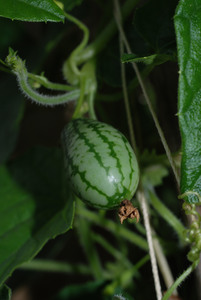
|
Cucamelon |
Annual
Full sun
Vines
Seed - direct sow, Seed - transplant
1 week after last frost
https://en.wikipedia.org/wiki/Melothria_scabra
Cucamelon, Mexikanische mini-gurke
60-70
23cm, 60cm
6.5-7.0
15-30°c (60-85°f)
Mouse melon
Cucurbitaceae
-3
67
Colombia, El Salvador, Guatemala, Honduras, Mexico Central, Mexico Northeast, Mexico Northwest, Mexico Southeast, Mexico Southwest, Nicaragua, Panamá, Venezuela
3-4 weeks before last frost
At last frost
https://powo.science.kew.org/taxon/urn:lsid:ipni.org:names:293320-1
|
Corn, Sunflowers and any other high growing plant, can act as a trellis. #### Propagation Direct sow when soil temperatures reach 15°C (60°F). Plant inside 3-4 weeks before planting outside, and use bottom-heat to help germination. Transplant when plant develop their third true leaf. #### Links [Cucamelon @ West Coast Seeds](https://www.westcoastseeds.com/products/cucamelon) |
Show
Edit |
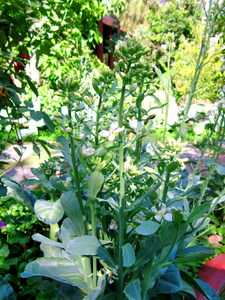
|
Gai lan |
Annual, Perennial
Full sun
Moist
20-48cm
Leaves
Seed - direct sow, Seed - transplant
1-2 weeks after last frost date
https://en.wikipedia.org/wiki/Gai_lan
Kai lan, Kailaan, Chinese broccoli, Chinese kale
30x30cm
10-30°c (50-85°f)
7-10 days
6.0-6.8
60-70
Fast
Brassicaceae
France, Great Britain, Spain
Albania, Algeria, Antipodean Is., Assam, Azores, Baltic States, Bangladesh, Belarus, Belgium, Bulgaria, California, Canary Is., Caroline Is., Central European Rus, Chatham Is., Chile South, China North-Central, China South-Central, China Southeast, Connecticut, Costa Rica, Crozet Is., Czechoslovakia, East European Russia, East Himalaya, Easter Is., Ecuador, El Salvador, Ethiopia, Falkland Is., Germany, Greece, Guatemala, Illinois, India, Iowa, Iraq, Juan Fernández Is., Kazakhstan, Kentucky, Kenya, Korea, Krym, Labrador, Lebanon-Syria, Libya, Madeira, Marianas, Marshall Is., Maryland, Massachusetts, Morocco, Netherlands, New Caledonia, New South Wales, New York, New Zealand North, New Zealand South, Newfoundland, North European Russi, Northern Territory, Northwest European R, Ohio, Ontario, Oregon, Pennsylvania, Prince Edward I., Queensland, Québec, Rhode I., Sardegna, Saudi Arabia, South Australia, South European Russi, Tadzhikistan, Tanzania, Tasmania, Texas, Trinidad-Tobago, Tunisia, Turkmenistan, Ukraine, Vermont, Victoria, Vietnam, Washington, Western Australia, Zaïre
Brassica oleracea
https://powo.science.kew.org/taxon/urn:lsid:ipni.org:names:279435-1
2-4 weeks before last frost date
At last frost date
3 to 7 years
https://powo.science.kew.org/taxon/urn:lsid:ipni.org:names:2934780-4
|
Can be grown as a perennial by cutting only 5cm above ground and leave root ball intact. Harvest before plants start to bolt and create buds/flowers. |
Show
Edit |